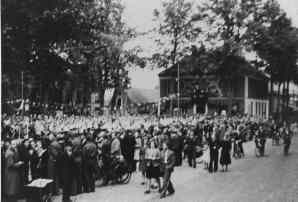  
  
  
  
  
  
  
|
The US families
Today in the US about 50 addresses of van Dort's
can be found. Most of them live in Holland, Zeeland or Grand Rapids, Michigan,
but they are both from Sri Lankan and Dutch families. Here you can find
a hypertext version on American
History and especially about The
United States of Amercia and The Netherlands.
Cornelis Hendricks van Dort, the pirate
The oldest van Dort, found in the US is Cornelis
Hendricks van Dort, who lived in Manhatten, New
Amsterdam, New
Netherlands, with his wife Magdalena
Dircks. New Amsterdam, nowadays New York, was by that time part of
the Dutch colonies, governed by the Dutch West India Company (WIC):
a Dutch company that existed from 1621-1791. The company activities comprised
shipping slaves to America, establishing Dutch colonies in the West Indies
and privateering.
In May 1647, when its last and famous governor Peter
Stuyvesant stepped ashore, New Amsterdamss population was generally
estimated at seven hundred, but some sources state that at that time no
more than a hundred people were living there. The town stretched from the
fort at the waterfront to the palisades which had been erected against
Indian raiders 25).
 Cornelis and Magdalena married in the early 1650's. The following information
is from Bob Fulkerson: "Cornelis
Hendricks van Dort was also known as "Cornelius Caper" in reference to
his trade as a privateer
(a pirate commissioned by a government to capture foreign ships and booty).
Mr. Caper was killed by Indians in the uprising of 1655 (November 9), which
was precipitated by the rash actions of his wife's uncle Cornelis
Van Tienhoven. Before Caper's death, he and Magdalene had one daughter,
Maria Cornelis (Marritje, baptized 4 February 1654, witnesses Jan Vigne
and Grietje Dircks). Magdalene was apparently unable to care for her daughter.
She raised funds using her house and property on Manhattan as collateral,
and pledged the money to the orphan court for raising the girl as an orphan.
Through this court, Maria became the ward of her grandmother's sister and
brother-in-law, Maria and Abraham Ver Planck."
Cornelis and Magdalena married in the early 1650's. The following information
is from Bob Fulkerson: "Cornelis
Hendricks van Dort was also known as "Cornelius Caper" in reference to
his trade as a privateer
(a pirate commissioned by a government to capture foreign ships and booty).
Mr. Caper was killed by Indians in the uprising of 1655 (November 9), which
was precipitated by the rash actions of his wife's uncle Cornelis
Van Tienhoven. Before Caper's death, he and Magdalene had one daughter,
Maria Cornelis (Marritje, baptized 4 February 1654, witnesses Jan Vigne
and Grietje Dircks). Magdalene was apparently unable to care for her daughter.
She raised funds using her house and property on Manhattan as collateral,
and pledged the money to the orphan court for raising the girl as an orphan.
Through this court, Maria became the ward of her grandmother's sister and
brother-in-law, Maria and Abraham Ver Planck."
Magdalene was quite a character and as such also known as The
Flying Angel, being constantly in trouble with authorities. Is Cornelis
Hendricks van Dort the same as the Cornelis Hendricks Van Dort, b1550-1649
Netherlands found in the World
Family Tree from the US? The latter database also contains a lot of
van Dort's, who have received US social security benefits.
The Dutch of Michigan and a print shop
As a result of the industrial revolution (1800) many people moved
to the big Dutch cities (Rotterdam , The Hague). Overpopulation of these
cities brought a lot of poverty, causing people to look for a better future
in the US. The end of the Golden Age (17th and 18th century) marked by
the conquest of the Netherlands by Napoleon caused a general decline of
the Dutch society. This lead to a counterreaction in the Dutch churches.
Conservative separatists believed that poverty was related to moral decline.
They actively sought to restore Protestant values of the 17th century.
Being opposed by both king Wiliam the First and the church, leaders of
these separatists looked for a better future in the US. They wanted to
start colonies there in order to practise their religious beliefs freely
and to build a prosperous community.
 Reverent van Raalte, 23)
The first group
of 53 separatists left in 1846 from Rotterdam to Winsconsin on
"The Southener" under guidance of reverent
van Raalte. Because of bad weather conditions they couldn't cross Lake
Michigan and Van Raalte decided to start their colony at Black Lake,
Michigan and named the
city Holland.
They were true pioneers, and sent for their families after establishing
the first settlements 23)
and 24).
A climate moderated by nearby Lake Michigan, ample trade routes through
lake ports and vast woodlands full of timber for building contributed to
a furious growth spurt in Holland's earliest days. In fact, by August,
1847, the community had attracted over 600 residents - most of Dutch heritage
- and by October the population had swollen to 1,700. For more information
about the history of Holland, see here.
Reverent van Raalte, 23)
The first group
of 53 separatists left in 1846 from Rotterdam to Winsconsin on
"The Southener" under guidance of reverent
van Raalte. Because of bad weather conditions they couldn't cross Lake
Michigan and Van Raalte decided to start their colony at Black Lake,
Michigan and named the
city Holland.
They were true pioneers, and sent for their families after establishing
the first settlements 23)
and 24).
A climate moderated by nearby Lake Michigan, ample trade routes through
lake ports and vast woodlands full of timber for building contributed to
a furious growth spurt in Holland's earliest days. In fact, by August,
1847, the community had attracted over 600 residents - most of Dutch heritage
- and by October the population had swollen to 1,700. For more information
about the history of Holland, see here.
As the Dutch immigrants
continued arriving in west Michigan, other Dutch-oriented settlements were
established in the region including Vriesland, Groningen and Zeeland
after the Dutch provinces and backgrounds of the colonists.
In 1890 and 1901 there is a publisher Anthony Van Dort in Grand Rapids,
Michigan. His print shop is recreated as a typical 1890's print shop at
the Public Museum of Grand
Rapids. The shop is part of a permanent exhibit called "Grand Rapids,
1890's" which has several recreated business's that were in Grand Rapids
at that time. The print shop has an actual printing press that is used
for demonstrations during group tours 7).
An example of print work from the 1890's is online: the Grand
Rapids Herald - 1890's Newspaper.

In 1913 a(nother?) publisher Van Dort can be found in Chicago.
From 1915 till 1922 G. Broes van Dort Co published more books in Chicago.
The name Broes probably indicates that the publisher has his roots in Bergen
op Zoom. The name Broes van Dort is first found with Karel Broes van Dort.
He got the name Broes from his mother Anna Maria Broes, lived in Goes and
was from the Bergen op Zoom family. After working as a clerk at court,
he later studied medicine and was a doctor in Goes, Zeeland (Netherlands).
He published several books including a book on leprosy in Indonesia. His
son also became a doctor.
American Army's 101st Airborne Division
In the twenties Arie
van Dort moved from Breukelen,
The Netherlands to New York. At that time he was 9. During WWII he served
in the American Army's 101st Airborne Division and was involved in the
liberation of Holland along Hell's
Highway (You can find everything about Operation
Market Garden there). After the invasion in Normandy he became a glider
co-pilot without (according to him) more knowledge of gliders than everything
that fitted on a stamp. They landed savely, but lost the other glider with
their amunition. Fortunately Dutch people helped them. The Dutch were surprised
to hear him speak Dutch, but the army didn't want to use him as a translator.
It gave him time to make a lot of friends in Holland. He still visits Holland
and has friends (t)here.

After being stationed in France, Bastonge, Germany and France again
he got permision in september 1945 to visit his grandmother, who still
lived in Holand. But traveling was difficult. He got by train to Antwerpen
and from there on a tram to Oosterhout, but then it was already Sunday
so there was no traffic. He found Canadian Head Quarters, where he was
given a ride to Eindhoven. There he found an American jeep at the gass
station, who gave him a ride to Veghel. But when they arrived in St. Oedenrode
there were celebrations of the first aniversairy of the liberation of The
Netherlands. And when they heard that Arie of "Won-o-Won" was there, he
was asked to do the honours of attending the diner festivity. After the
festivities, he arrived in Utrecht at his aunt's by bus. He spent some
days with his aunt, looked up the old pub of his grandfather in Breukelen
(it's still there and according to him didn't change much since 1927) and
finally arrived in Amsterdam at his grandmother's. 12)
 The 1st anniversary of the liberation of St. Oedenrode,
september 1944,
Photo by Arie van Dort 12)
The 1st anniversary of the liberation of St. Oedenrode,
september 1944,
Photo by Arie van Dort 12)
|



